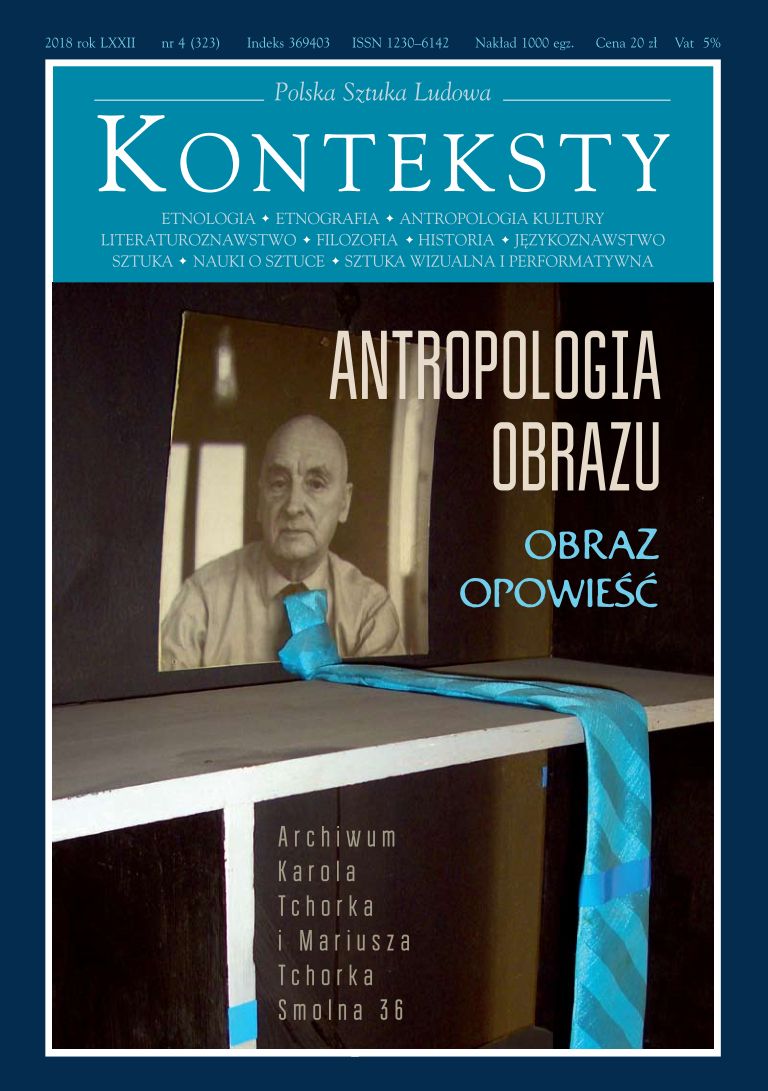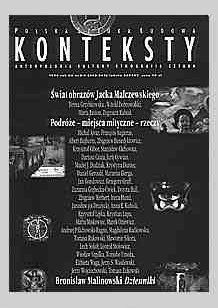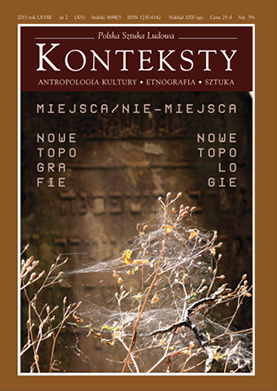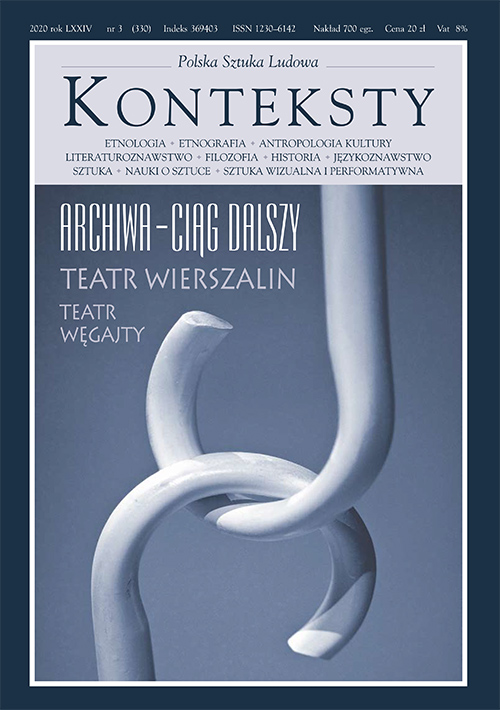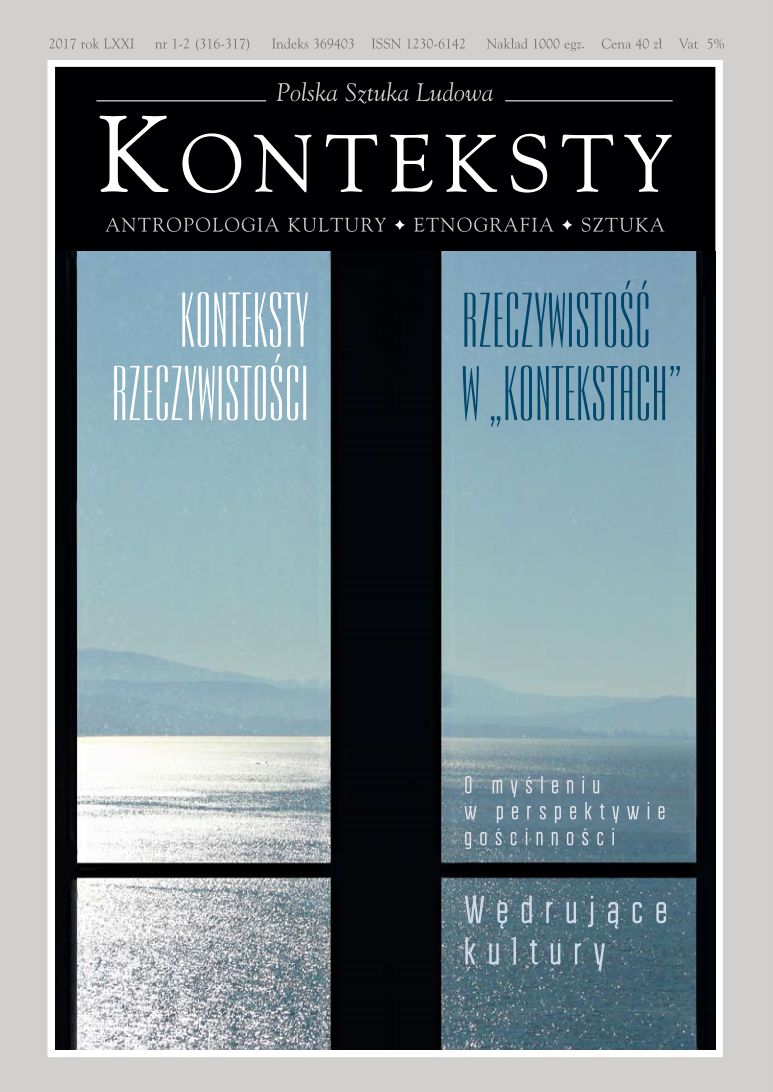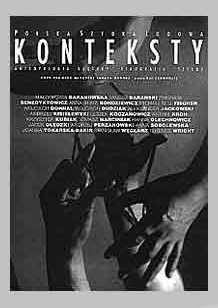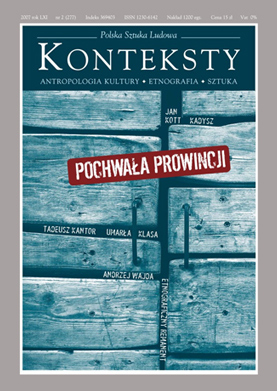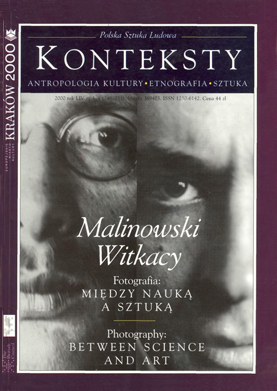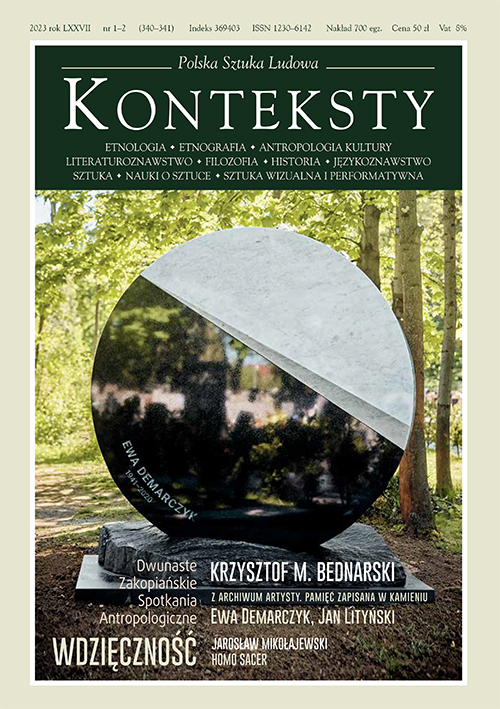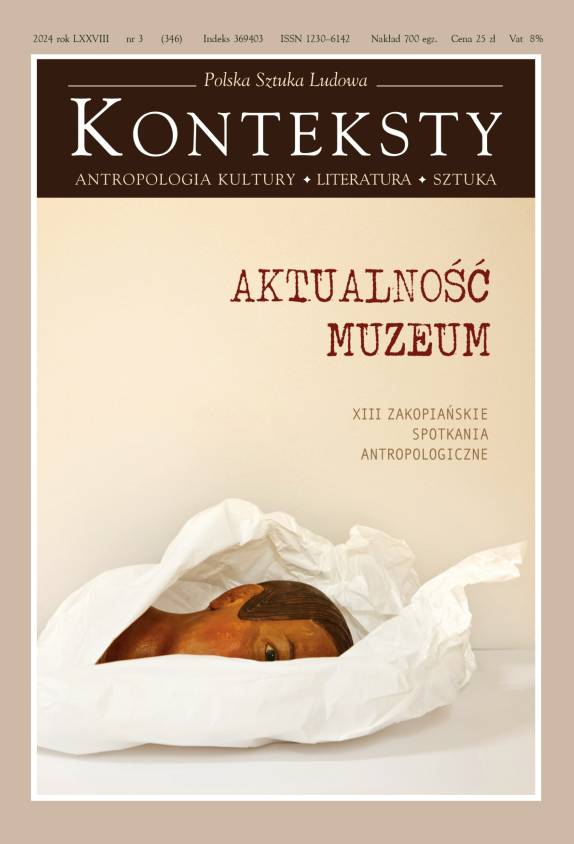Issue 2009/4 (287) -

| Dariusz Czaja | Animals in a Cage of Languages  | 2 |
In this introduction to the current issue the author drew attention to the enrootment of the contemporary discourse about animals in assorted philosophical and world outlook languages inherited from history, arguing that there is no cognitively innocent language for talking about animals. More, D. Czaja brought to the fore the difficulties of linguistically (and not only) tackling the problem and the man-animal relation within the humanistic reflection on man. The texts presented in this issue of ”Konteksty” attempt to make the reader aware of the topicality and importance of the animal question. | ||
| N. N. | Philosophers and Animals. Poets and Beasts: Excerpts from Books of Use, selected and prepared by Dariusz Czaja  | 10 |
At least from the time of Nietzsche animals have been causing man’s jealousy since the latter has been increasingly avidly asking himself: am I still a living creature or perhaps already a dead one? Am I truly alive or perhaps I only think I am? Meanwhile, the animal appears to be an embodiment of vital certitude: it seems to be a living creature in relation to which man always measures his vital forces on a diminishing scale. Ever since man longed for life as one of the ”natural rights” promised by the modern epoch, he started to compare himself to animals – and usually did so to his own detriment. Suspended in a sphere “between“ life and death, man perceives himself, as Eric Santner recently said, as “un-dead“. We have been extracted from life from the very onset and without hope for revival: departure from Nature, that great Exodus which has rendered us moral and speaking human beings, always and invariably takes place under the auspices of death. Denaturalisation, due to which we gain language, is connected with an irreversible loss of life that can, at best, become the phantasmatic object of nostalgic desires. The author of the presented essay would like to ponder on that ostensibly definitive thesis. Does denaturalisation actually denote the loss of life, or, on the contrary, does it open life up to new opportunities unknown to the animal existence, enclosed within the range of natural laws? | ||
| Agata Bielik-Robson | Vitalism: Reactivation, or on the Philosophy of Life in a New Form  | 27 |
An attempt at a detached view of the religious sources of the present-day ecological crisis, going much deeper than, as it is most often claimed, the beginnings of the modern era. Upon the basis of mythological and religious texts the author followed the constant tension and battle between that which is “human” in man and that which is “animal”; in doing so, he reveals the profound contradiction between the desire to attain the divine ideal and the descent into animal impulses. Particular attention has been paid to the cultural and civilisational role of the cosmogonic and anthropogonic myth in the Biblical Book of Genesis. The author subjected to a detailed exegesis the contents and consequences of the two “programmes of Jehovah” contained therein, pertaining to the destiny of man and his role in the created world. I. Kania perceived the sources of man’s exploitation-oriented attitude towards Nature in the “imperial” interpretation of the Biblical pericopes about the dominating position of man in the world. | ||
| Ireneusz Kania | Two Programmes of Jehovah and the Sources of the Contemporary Ecological Crisis  | 40 |
An attempt at a detached view of the religious sources of the present-day ecological crisis, going much deeper than, as it is most often claimed, the beginnings of the modern era. Upon the basis of mythological and religious texts the author followed the constant tension and battle between that which is “human” in man and that which is “animal”; in doing so, he reveals the profound contradiction between the desire to attain the divine ideal and the descent into animal impulses. Particular attention has been paid to the cultural and civilisational role of the cosmogonic and anthropogonic myth in the Biblical Book of Genesis. The author subjected to a detailed exegesis the contents and consequences of the two “programmes of Jehovah” contained therein, pertaining to the destiny of man and his role in the created world. I. Kania perceived the sources of man’s exploitation-oriented attitude towards Nature in the “imperial” interpretation of the Biblical pericopes about the dominating position of man in the world. | ||
| Arkadiusz Żychliński | The Non-existent Animal. Experimentum de hominis natura  | 51 |
The article endeavours to propose a critical outline of the interpretation space within which the admirers of post-humanistic attempts at establishing a new economy of relations between the animal and human worlds recognise Giorgio Agamben as an adherent of the cassation of a caesura separating man from animals. This attribution, popular within the context of the animal studies energetically developing in recent years, proves to be difficult to maintain upon the basis of an unbiased acquaintance with Agamben’s book L’uomo e l’animale. A re-contextualisation of the Agamben project proposed in further parts of the sketch makes it possible to reconstruct the course of his argumentation from the viewpoint of a formula of post-humanistic anthropology (i.e. a non-anthropocentric anthropology) sought by this philosopher. From this vantage point, Agamben appears to be not so much a spokesman for the abolition of the anthropological difference as a supporter of its profanation, i. e. a neutralisation of its destructive effects. | ||
| Paweł Mościcki | The Animal Which I’am Dying. Heidegger, Derrida, Agamben  | 61 |
This text tries to reconstruct a debate concerning the philosophical status of the relation between man and animal. The author outlined the conception proposed by Martin Heidegger and then cited its critical presentations by Jacques Derrida and Giorgio Agamben. Their deconstruction of the German philosopher’s discourse comprises a radical attempt at severing links with the anthropocentric tradition of philosophy. The ultimate objective of the reflections pursued in the essay is, however, not yet another critique of metaphysics, but saving man from the desperate gesture of enrooting the specificity of his existence in a privileged relation with death. In this manner, man is supposed to not only come closer to others but also to distance himself from death. | ||
| Łukasz Musiał | Man-animal-Kafka  | 69 |
The presented essay analyses the animals appearing in the works of Franz Kafka, particularly often in the last years of the life of the author of The Trial. The realised conceptions are anticipated to a great extent by one of Kafka’s earlier stories, A Report to an Academy, whose narrator is a chimpanzee subjected to humanisation. The fate of the leading protagonist could be treated as a concise history of anthropogenesis and, by following the example of Giorgio Agamben (L’aperto. L’uomo e l’animale), as the history of the origin and activity of the so-called anthropological machine, a motor force of the historization of man that places him outside the natural order. The subsequent stories by the author of The Metamorphosis continue those motifs, at the same time transcending the horizon delineated by them. The animal characters become increasingly ambiguous and are no longer animals or people concealed behind animal facades. They have turned into „deformed” creatures, to cite an expression coined by Walter Benjamin in relation to the world of Kafka’s works. The closing fragments of the essay analyse this „deformed” world and the amorphous creatures populating it, especially Odradek, the protagonist of a brief text entitled The Householder’s Concern. | ||
| Roger Caillois | Sorcery  | 76 |
A fragment of Caillois’ book Méduse et Cie. The author traced the parallel between the world of animal mimesis (insects) and that of humans (masks). | ||
| Paul Badham | Do Animals Have Immortal Souls?  | 79 |
This concise sketch written from the standpoint of Christian theology is more of an attempt at posing an important question perturbing the believers than a radical and unambiguous solution to it. The author conducted a radical recapitulation of the Aristotelian-Thomist and Cartesian conceptions of the soul and interpretations dominating the European discourse on the soul. In doing so, he also discussed the biologist stands (evolutionism, etiology). The summary proclaims that there are certain reasons for believing that the immortal soul is due only to human beings. Nonetheless, the still prevalent ignorance about the animal „interior” does not permit to authoritatively refuse this human privilege to animals. | ||
| Brian Klug | Can We See a Moral Question about Animals?  | 84 |
Brian Klug’s essay discusses a fundamental issue concerning the attitude towards the treatment of animals in terms of scientific experiments: are we able to apply a moral question to these beings? Klug examines the logic of the physiologist frame of mind that ignores this question, taking as examples two individuals representing such an approach – the fictional Dr. Moreau from the novel by H. G. Wells and a 19th century scientist, Claude Bernard, who wrote Introduction to the Study of Experimental Medicine. Rather than answering the question whether we should perform experiments on animals or not, the author insists on ensuring that the moral question about animals is on the agenda. | ||
| Andrew Linzey | Genetic Engineering as Animal Slavery  | 90 |
The author of the presented last chapter of a theological dissertation about animal theology totally rejects the idea that animals should be subjected to genetic manipulation in order to turn them into sources of meat or laboratory spare parts. Instead, he suggests that from the perspective of animal theology the practice of the genetic transformation of animals, rendering them mere measures for the attainment of human targets, is morally tantamount to the institutionalisation of slavery. A. Linzey argues that an unrestrained development of genetics, which recognises no limitations with the exception of those connected with the progress of the dominating species, is morally condemnable. | ||
| Grzegorz Dyduch | The Guinea Pig – the Isaac of Postmodernity?  | 100 |
In the background of this personal reflection (the author is a histopathologist) about medical experiments conducted on animals lies professional interest and medical practice. Dyduch demonstrates the numerous ethical and cognitive complications associated with various attitudes towards such experiments. He argues that there are no simple solutions as regards medical research involving animals, and postulates to avoid unambiguous ethical fore-judgements in favour of a careful examination of each individual case. | ||
| Andrzej Stasiuk | Bitch  | 103 |
The topic of this literary impression is a description of the last days in the life of a bitch, which for many-years lived at the author’s home in the Beskidy Mts. | ||
| Krzysztof Konieczny | Cranes  | 106 |
This text, written by a naturalist and an ornithologist, has two aspects. On the one hand, it is a personal and, at same time, poetic record of an encounter with a flock of cranes in a woodland recess, and on the other hand it remains a professional account about the birds (their mating season, hatching, flights). | ||
| Dariusz Czaja | A Painted World. The Mythologies of the Hunt  | 110 |
In Western culture hunting has a long and historical lineage and is regarded as one of the cultural practices sanctioned by age-old tradition and customs. Today, despite the fact that it has ceased being a life necessity, it still remains a lively fragment of that culture. The hunt has turned into an exciting form of spending leisure time and a phenomenon situated between a hobby, entertainment and sport. The presented text seeks an answer to questions about the mythological dimension of the chase. The author carried out a critical deconstruction of the universal myth of the hunt upon the basis of two instructive books: Zbigniew Kruczyński’s Farba znaczy krew and Tomasz Matkowski’s Polowaneczko. He was interested in the r e a l (and not merely imaginary) image in contemporary culture, and thus endeavoured to recreate the mental premises at the basis of hunting and to demonstrate their consequences (for Nature and man). Concluding, D. Czaja asserted that the contemporary hunt is ’intellectual tomfoolery, a cultural absurdity and an ethical scandal” and demanded its delegalisation. | ||
| Tomasz Szerszeń | The Abattoir, 1929 A.D.  | 126 |
A report by Eli Lothar concerning Parisian slaughterhouses, published in 1929 in the avantgarde periodical “Documents”, is actually an anthropological meditation about the symbolic borderline between that which is human and that which is animal… | ||
| Monika Kozień | A Piece of Meat. On Eating Animals  | 130 |
Eating is not solely a simple physiological activity but also an extensive network of cultural codes describing the individual and constructing group identity. The question of meat is one of the most vital culinary issues, present in social discourse from the beginning of time. On the one hand, meat is the spoil of the savage predator, dripping blood, arousing the most primitive instincts, proudly displayed and eagerly devoured; on the other hand, it is nourishment, whose origin is timorously concealed under a thick layer of complicated processing. The preparation and consumption of meat is identified, and still is, with prestige. Human consciousness continues to retain the image, cultivated in the past, of the ancestor as a valiant hunter, for whom eating meat was the cause of special pride. The twentieth century, and in particular its second half, pluralized attitudes towards food and relativised their assessment together with the growing popularity of vegetarianism. The preparation and consumption of meat are no longer treated as natural, and are increasingly often regarded as a symptom of deviation. From mystical activities they changed into a secularised and often shamefaced process of simply filling the stomach. | ||
| Marta Miskowiec | Genre Scenes with a Snow Panther. On Animal Photography  | 137 |
Just as any other sort of photography, animal photography is neither the place nor the source of natural relations with the world. Photographic imagery, shaped within the progress of the art of depiction, creates a sui generis communiqué, which we receive while barely aware of its existence and believing that the photograph is rather a „mirror of nature” and does not additionally manipulate our awareness. Photographs of pets, wild animals and game provide vast information about our reflections about animals. The titular „snow panther” is a reference to Peter Matthiessen’s The Snow Leopard, which proposes an alternative way of getting to know wild animals via respectful co-existence. | ||
| Marta Tarabuła | Tiger Cuts of Beef  | 143 |
The author traced the fascinating and only slightly examined fragment of contemporary art: the distinct presence of animals in so-called new expression painting. By referring to numerous examples, she discussed animalistic motifs in twentieth-century art (i.a. R. Grzyb, M. Sobczyk, J. Modzelewski), indicating their biographical and purely aesthetic contexts. | ||
| Aleksandra Melbechowska-Luty | The Figure of the Horse in Polish Culture. Notes from Private Hypology  | 151 |
A panoramic attempt at depicting the motif of the horse in Polish post-partition art, which featured the ethos of chivalry, struggle and heroism as well as tradition, customs and work associated with the gentry manor house and the countryside. Another component was the enormous sentiment and even love for the horse, the only creature to be endowed with a soul. The Polish mythology of the steed revealed a specific type of historical memory supporting the feeling of national identity, of great significance for generations living during the partition era. Artists resorted to traditional images of past centuries, created heroic narrations about the deeds of famous men and celebrated battles and knightly duties; here, horse and man are heroes enjoying equal rights. | ||
| Magdalena Barbaruk | Is el toro bravo a European? | 159 |
| Maja Kostecka | The Cat. An Unforeseeable Project According to Bruno Latour  | 166 |
The article tries to apply the methodological conception devised by Bruno Latour for research into relations between man and animals. The reflections concern a concrete group of animal owners who breed pedigree cats, and with whom the author has been cooperating for a number of years. The Latour mythology proves to be of help for analysing a „project” involving the cat, an ideal representative of the species in the eyes of its breeder. At the same time, it discloses discrepancies contained in the very idea of the possibility of designing an object of culture as complicated as a living animal. Pedigree cats are something more than the sheer dreams of their designers, and biology turns out to be a partner and not a passive substance. The text refers to the traditional objects of interest of cultural anthropology – the relations between man and the natural environment. | ||
| Filip Wróblewski | An Animal in the Exact Meaning of the Word  | 174 |
The author aimed at a creating a typology of common ways of conceptualising the notion of the „animal” in the Polish language and culture. He also indicated dependencies between the world outlook shaped under the impact of culture and the way of perceiving animals, and thus their treatment. Upon the basis of research material collected amidst 140 students it has been possible to indicate 13 ways of defining animals in everyday thought. Despite the extraction of ways of defining animals based on empathy, the dominating stand appears to be a supremacy definition, stressing man’s superiority vis a vis animals-things. It recalls a reification interpretation enrooted in language and culture, which reduces animals to the role of useful products-raw material „serving man”. | ||





